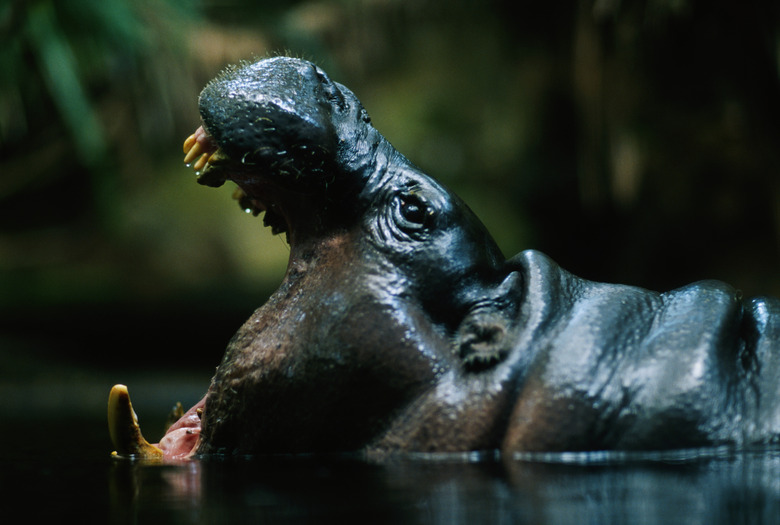Facts About Animals Of West Africa
Africa is home to an extremely wide variety of animals, from the very tiny army ant to the towering giraffe. West Africa, which stretches from harsh desert to fertile seacoast, lays claim to an impressive share of that faunal diversity. From the West African manatee and pygmy hippopotamus to the Diana monkey and zebra duiker, there is no dearth of interesting critters in this corner of the continent.
West African Manatee
West African Manatee
The large gray West African manatee, also called along with its relatives a "sea cow," has tiny flippers and a flat, rounded paddle for a tail. Weighing in at nearly 500 kilograms (1,100 lbs.), adult manatees can grow to as long as 4 meters (13 feet). They inhabit coastal areas including lagoons, rivers, estuaries and lakes. Manatees feed on overhanging vegetation, from grasses to mangrove foliage. They can be found from southern Mauritania to Angola, though their population is in decline due to hunting and capture in fishing nets: West African manatees are legally protected animals, but poaching continues to impact them. While manatees the world over are in danger of extinction, this species is the most threatened of all.
Pygmy Hippopotamus
Pygmy Hippopotamus
The West African pygmy hippopotamus can be found in the lowland and wet forests of Sierra Leone and Cote d'Ivoire, specifically in and near the Bandama River. Typically about 1.5 meters (5 feet) long, the pygmy hippo is much smaller than the more widespread common hippo, one of the biggest mammals on the planet. The species is also substantially less social than its giant relative: Pygmy hippos tend to be found alone or in small groups, whether resting in rivers or swamps or foraging onshore.
Black Colobus Monkey
Black Colobus Monkey
Portions of Cameroon, Equatorial Guinea, Gabon and the Republic of the Congo are home to the black colobus monkey – one of the 10 most endangered monkey species in all of Africa. These primates reside in the high canopies of the rain forest and can jump up to 15.2 meters (50 feet) between trees, using their mantle hair and tails as parachutes. Colobus monkeys rarely descend to the ground and eat the leaves from the trees in which they live. They lack thumbs; the name "colobus" comes from the Greek word meaning "docked" or "mutilated." The monkeys have black fur that contrasts with a white mantle and tail. They're usually found living in "troops" of between five and 10 monkeys, including a dominant male, females and young.
Niger Stingray
Niger Stingray
The Niger stingray, also known as the smooth freshwater stingray, is endemic to three West African drainages: particularly the Niger/Benoue system, but also the Sanaga and the Cross rivers. Possessed like most stingrays of venomous barbs, this cartilaginous fish, which may be 40 centimeters (15.7 in.) long, feeds upon aquatic insects. The International Union for the Conservation of Nature lists the global population as on the decline, suggesting overfishing and habitat modification as probable culprits.
West African Dwarf Crocodile
West African Dwarf Crocodile
From Togo to Burkina Faso, Benin to Mali, the West African dwarf crocodile can be found in all West African countries in freshwater, tropical rain forests and tropical grassland alike. This reptile eats fish, frogs, birds, small mammals and crustaceans. The name reflects its status as the world's smallest crocodile: Adults are typically a mere 1.9 meters (74.8 in.) long. Usually solitary or associating in pairs, dwarf crocodiles hole up at the water's edge in burrows. They hunt at night along riverbanks. Conservation-wise, the species is not as vulnerable as other crocodiles, hunted for their hides, since the dwarf's skin is not considered valuable. Their lifespan can be anywhere from 50 to 100 years.
Zebra Duiker
Zebra Duiker
Sierra Leone and Cote D'Ivoire are home to the zebra duiker, an antelope species found in low-lying forests and river valleys. It has black, vertical stripes over cream colored skin on its mid-torso; the head, neck, rear and limbs are usually red-brown in color. The animals weigh some 17.7 kilograms (39 lbs.) on average and around 46 centimeters (18 in.) in height. The zebra duiker has short limbs in relation to its body, as well as short, rounded horns. It mates monogamously, preferring solitude before it finds a partner. Its diet consists of fruit, leaves and shoots. The animal's habitat is threatened due to logging and habitat degradation.
White-Breasted Guinea Fowl
White-Breasted Guinea Fowl
Forest destruction has also negatively impacted the white-breasted guinea fowl, resulting in a swift decline in population in the early 21st century in Sierra Leone, Liberia, Cote D'Ivoire and Ghana. They may utilize both primary and secondary tropical forests. The birds are around 43 centimeters (17 in.) in length with a bare red head and upper neck above a white lower neck, upper back and breast; the rest of their feathers are black. They live in pairs or groups of up to 24 individuals. The guinea fowl lives on a diet of seeds and berries as well as insects and other small invertebrates.
References
- The IUCN Red List of Endangered Species: Trichechus senegalensis
- Public Broadcasting Service: Africa — Explore the Regions: Rainforests
- The IUCN Red List of Endangered Species: Dasyatis gerouaensis
- BirdLife International: White-breasted Guineafowl
- Animal Diversity Web: Cephalophus zebra
- African Wildlife Foundation: Colobus Monkey
Cite This Article
MLA
Walkley, A.J.. "Facts About Animals Of West Africa" sciencing.com, https://www.sciencing.com/animals-west-africa-5377302/. 24 April 2017.
APA
Walkley, A.J.. (2017, April 24). Facts About Animals Of West Africa. sciencing.com. Retrieved from https://www.sciencing.com/animals-west-africa-5377302/
Chicago
Walkley, A.J.. Facts About Animals Of West Africa last modified March 24, 2022. https://www.sciencing.com/animals-west-africa-5377302/
